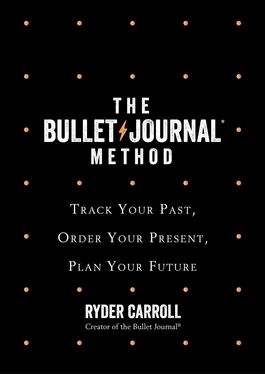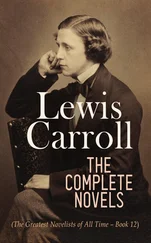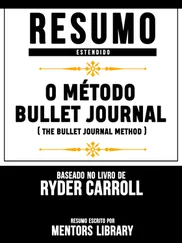By 2007, I was working as a web designer for a big fashion label headquartered in the neon heart of New York City, Times Square. I’d gotten the job through a friend who worked there and was struggling to plan her upcoming wedding. Her desk was littered with notebooks, Post-its, and scraps of paper a couple of inches deep. It looked like one of those manic conspiracy map rooms you see in crime shows.
I’d been looking for a way to repay her for getting me the position. So one day, as I saw her scrounging for yet another wayward note, I awkwardly offered to show her how I used my notebook. She turned to me with raised eyebrows, and to my surprise—and horror—she took me up on the offer. Gulp. What had I gotten myself into? Sharing my notebook was like offering someone an unadulterated look into my mind, which, well . . . yeah.
A few days later we went for coffee. My clumsy tutorial took a while. I felt deeply vulnerable exposing how I organized my thoughts—the symbols, the systems, the templates, the cycles, the lists. To me, these were the many crutches invented to support a faulty brain. I avoided making eye contact until I was finished. Mortified, I looked up. Her gaping mouth instantly validated all my insecurities. After an excruciating pause she said, “You have to share this with people.”
After the awkwardness of that tutorial, it took a lot more prodding for me to share my system. But over the years, I found myself fielding shy questions from designers, developers, project managers, and accountants about my ever-present notebook. Some asked about organizing their day-to-day. So I showed them how to use my system for quickly logging their tasks, events, and notes. Others asked about setting goals. So I demonstrated how they could use my system for structuring action plans to tackle future aims. Others just wanted to be less scattered, so I showed them how to neatly funnel all their notes and projects into one notebook.
It had never occurred to me that these solutions I’d devised could be so widely applicable. If someone had a specific need, it was easy to modify one of my techniques to support it. I started to wonder whether sharing my solutions to common organizational challenges might help others avoid, or at least mitigate, the frustration I had endured earlier in my life.
All well and good, but if I was going to open my mouth again, there would be no more awkward freestyling. I formalized the system and streamlined it, stripping away everything but the most effective techniques I had developed over the years. Nothing exactly like it existed, so I had to invent a new language with its own vocabulary. This made the system significantly easier to explain—and, I hoped, to learn. Now it needed a name, something that spoke to its speed, its efficiency, its heritage, and its purpose. I called it the Bullet Journal.
Next, I launched a website featuring interactive tutorials and videos that walked users through the newly minted Bullet Journal system, aka BuJo. I smiled when the site passed 100 unique visitors. To me, that was mission accomplished! Then the unexpected happened. Bulletjournal.com was featured on Lifehack.org. Then on Lifehacker.com, then in Fast Company , and from there it went viral. The site went from 100 to 100,000 unique visitors in days.
Bullet Journal communities sprouted up across the web. To my astonishment, people were openly sharing their approaches to dealing with deeply personal challenges. Veterans shared their tactics for coping with PTSD by tracking their days in their Bullet Journals. People suffering from OCD shared ways to distance themselves from their overpowering thoughts. I was touched hearing from those like myself suffering from ADD as they shared how their grades improved and their anxiety diminished. In the often toxic world of online communities, these Bullet Journal groups created incredibly positive and supportive spaces, each focusing on different challenges, all using the same tool.
Sandy stumbled upon Bullet Journaling in May 2017, through a video on Facebook. Lack of sleep and caring for a toddler left her extremely disorganized and forgetful, which is not how anyone would normally describe her. Thoughts ran through her mind like squirrels: Had he slept long enough? Were his immunizations on track? When was that preschool application deadline again? As soon as she put one task to rest, another popped up in its place. She felt stressed and demoralized. Did other moms know something she didn’t? So when she heard about an organizational system requiring just a notebook and a pen, she felt she had nothing to lose.
The first step was to create a log of everything she had to do that month. She wrote each family member’s schedule in separate columns. They all worked irregular hours. It felt like she could finally press pause on the roller coaster for long enough to see who would be where for the next four weeks. It was horrifying to think about how easily one of them could forget to pick up their baby from preschool in a few years. It felt like it was just a matter of time before they would forget something important.
Sandy resolutely drew another column. She wrote down events and birthdays so they were easily visible. On her monthly financial log, she listed when bills were due and how much she’d paid. She also added daily boxes to track habits and goals—or just a reminder to stop and breathe!
Writing by hand was strangely soothing. Sandy didn’t want to set her hopes too high, though, when so many other systems had promised to get the organized side of herself back without delivering long-term change.
Sandy moved on to the next part of the instructions. They were intended to help her keep sight of the bigger picture. What were her aspirations for the coming year? On her Yearly Goals page, she dared to write down a passion project that she’d been weakly attempting for years—with no progress to show for it. Was her OCD sabotaging her resolution to spend more time lettering and drawing? Or was she just too busy? All she knew was that she had potential she wasn’t using.
Over the coming weeks, Sandy’s habit of sitting down with her Bullet Journal became as effortless as brushing her teeth. Silly as it seemed, crossing off little boxes kept her motivated by reminding her that there was a finite number of tasks to do every day. She didn’t forget about a single bill. Nor did she have to send any long, apologetic texts for forgetting someone’s birthday. Another surprising thing was that the layout of the Bullet Journal reminded her that mundane tasks were part of the bigger picture. The Monthly Goals and Yearly Goals pages showed her every day that she had a long game, and that she was on her way. Her trick was to add a tiny passion project—say, 15 minutes of lettering by hand—to every Daily Log, and to do it first thing every day. She always had 15 free minutes if she took them before checking her phone. It was like time had expanded.
Soon Sandy noticed that journaling garnered more benefits than just keeping her organized and sane. All her life, she’d suffered from a condition called dermatillomania, also known as compulsive skin-picking disorder, that she’d been ashamed of her whole life. For Sandy, it was mostly concentrated on her fingers. She’d canceled meetings and interviews because she felt her fingers looked horrible. Sometimes she couldn’t sleep because of the pain, and she’d constantly dropped things and was unable to do the simplest of tasks. For example, she’d always asked her husband or her mom to help her squeeze some lemon for her tea to avoid the biting pain of the acidic sting.
After Bullet Journaling for a few months, she found herself in the kitchen, tears welling up in her eyes. She looked down at her hands, finally squeezing a lemon, and realized that her fingers were no longer covered with wounds. With every line, letter, and notation she made, she’d kept her hands busy and let them slowly but surely heal. I’ve included the special page she designed in her journal to commemorate the day.
Читать дальше


![Райдер Кэрролл - Bullet Journal метод [litres]](/books/407399/rajder-kerroll-bullet-journal-metod-litres-thumb.webp)









